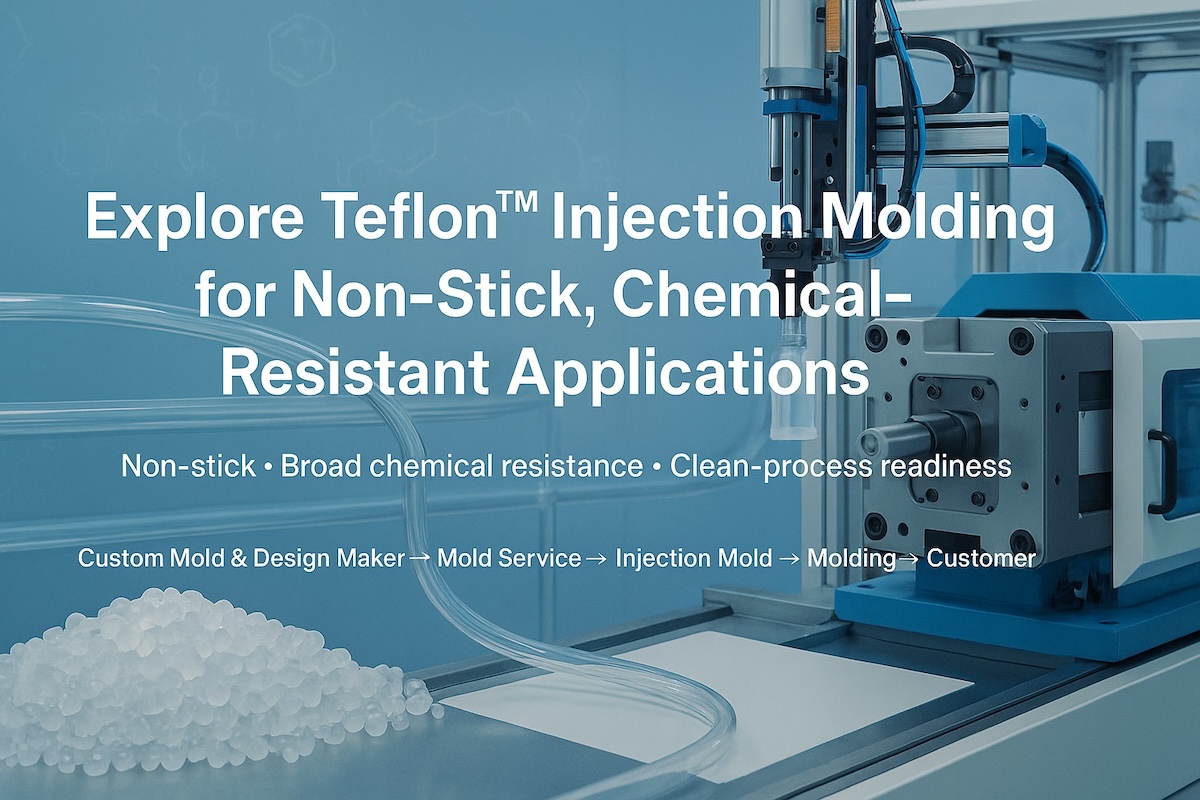Explore Teflon Injection Molding for Non-Stick, Chemical-Resistant Product Applications
Explore Teflon Injection Molding for Non-Stick, Chemical-Resistant Product Applications

Explore Teflon Injection Molding for Non-Stick, Chemical-Resistant Product Applications
Non-stick surfaces • Broad chemical resistance • Clean-process readiness
Looking for “Teflon injection molding near me”? If your project needs parts that shrug off chemicals, resist sticking, and run reliably in harsh environments, melt-processable fluoropolymers (often marketed under the Teflon™ brand family) are a strong fit. This guide explains what’s truly injection-moldable, how to design for success, and how TaiwanMoldMaker.com helps you hit strict timelines from RFQ to SOP.
Explore our end-to-end services:
Custom Mold & Design Maker → Mold Service → Injection Mold → Molding → Customer Examples → Contact
First things first: what can (and can’t) be “injection-molded Teflon”?
-
PTFE (the material most people mean by “Teflon”) is not melt-processable; it’s typically paste-extruded or compression-molded and sintered.
-
Injection-moldable fluoropolymers with “Teflon-like” performance include PFA, FEP, ETFE, and PVDF. These deliver excellent chemical resistance and low surface energy (non-stick), with different heat and mechanical profiles.
-
If you need true PTFE performance in an injection-molded assembly, options include insert-molding PTFE pieces, lining/sleeving, or post-applied PTFE/PFA coatings on metal or polymer substrates.
We’ll help you select the right path—mold PFA/FEP/ETFE/PVDF, or combine PTFE via inserts or coatings—based on cost, performance, and lead time.
Material quick-selector (practical cheat sheet)
| Material | Injection-moldable | Continuous use temp (approx.) | Chemical resistance | Transparency | Typical uses |
|---|---|---|---|---|---|
| PFA | Yes | ~260 °C | Excellent (near-PTFE) | Clear | Semiconductor wet-process parts, labware, spray nozzles |
| FEP | Yes | ~200 °C | Excellent | Clear | Tubing, valves, check balls, non-stick components |
| ETFE | Yes | ~150 °C | Excellent | Translucent | Chemical pumps, wire jackets, clips, cable ties |
| PVDF | Yes | ~150 °C | Very good | Opaque | Chemical handling, membranes, fittings, fluid paths |
| PTFE | No (not melt-process) | ~260 °C | Outstanding | Opaque | Liners, rings, seals (via compression/sintering) |
Values are typical ranges; confirm with grade datasheets for your application (food contact, UV, FR, purity, etc.).
Ideal application profiles
-
Corrosive fluids & CIP/SIP: Manifolds, valve bodies, impellers, spray/atomizer parts, quick-disconnect fittings.
-
Non-stick handling: Hopper/feeder components, anti-stick fixtures, release-friendly seals and check balls.
-
Clean environments: Semiconductor wet benches, labware, pharma/bioprocess fluid paths (with high-purity grades).
-
Electrical & outdoor: ETFE/PVDF parts with UV and weather resistance for connectors, housings, and cable management.
Design & DFM guidelines for fluoropolymer molding
-
Wall sections: Keep uniform where possible; use ribs/bosses instead of thick masses to curb sink and cycle time.
-
Draft & radii: Provide generous draft (≥1–2°) and smooth radii; low surface energy can aid ejection but parts are dimensionally sensitive.
-
Gating: Prefer edge or fan gates to reduce shear/voids; keep residence time short. For high-temp resins (PFA), use corrosion-resistant hot parts or cold runners when appropriate.
-
Venting: Fluoropolymers outgas; design robust venting and avoid dead zones.
-
Tolerances: Plan for higher thermal expansion vs. engineering plastics; critical features may need post-machining.
-
Metal choices (tooling): Use corrosion-resistant steels and protect hot runners/screws/barrels; consider nickel-based alloys or coatings for aggressive duties.
Typical processing window (reference starting points)
-
Drying: PVDF/ETFE often need pre-dry (e.g., 80–120 °C); PFA/FEP are less hygroscopic—follow grade datasheets.
-
Melt temperature: ~260–290 °C (PVDF/ETFE) → up to ~360–380 °C (PFA/FEP).
-
Mold temperature: 60–120 °C depending on resin and cosmetic requirements.
-
Cycle strategy: Short residence, conservative shear, controlled pack/hold to protect crystal structure and surface.
We’ll lock the exact window during DOE at T0/T1.
Timeline you can hold suppliers to (strict-lead-time model)
-
Day 0–2: 48-Hour DFM + risk log (fill/cool/warpage, gate plan, cycle model) → approve.
-
Day 3–10: Tool build (Al/hybrid) + polish/texture for pilot; corrosion-resistant hot parts specified.
-
Day 11–13: T0 in production resin; weight ladder, gate freeze, surface tune.
-
Day 14–15: T1 pilot; FAIR + CMM/scan; ship FA parts.
-
Day 16+: Copy-cavity proposal and ramp plan.
Need production steel first? Expect Day 3–20/28 depending on complexity/cavitation.
RFQ checklist (copy/paste)
-
Target T1 ship date + must-hit gates (DFM/T0/T1).
-
Resin family & grade options: PFA/FEP/ETFE/PVDF (purity, FR/UV, food/medical compliance).
-
Environment & chemicals: Temp, pH, solvents, sterilisation (CIP/SIP, gamma).
-
Cosmetics & finish: Surface energy targets, texture (SPI), gloss/ΔE if visible.
-
Tool plan: Al vs. steel, cavitation, valve vs. cold runner, corrosion-resistant hot parts, conformal-cooling candidates.
-
Validation scope: DOE, FAIR, CMM/scan, CpK @ CTQs; cleanliness/purity testing if required.
-
Automation & test: EOAT take-out, leak/weld/mark, inline vision SPC.
-
Data/MES: OEE, CpK, scrap, kWh/kg, lot genealogy (shareable dashboards).
-
Logistics: FA courier, export packing (anti-rust, fumigated crates), Incoterms.
Send your package here → Contact
How TaiwanMoldMaker.com delivers “local outcomes” fast
-
Networked capacity you can see: Press list, toolroom hours, and live schedules with escalation paths.
-
Fluoropolymer-ready cells: High-temp/corrosion-resistant screws & hot halves, fume capture, clean-area molding.
-
Rapid bridge tools → production steel: Conformal-cooled inserts where ROI is strong.
-
Vision + MES guardrails: First-time-right T0/T1s, remote audit links for stakeholders.
-
Dual-plant strategy (Taiwan + SE Asia): Surge capacity without re-qualification.
Start your project:
Injection Mold → Molding → Mold Service → Contact
Notes & trademark
Teflon™ is a trademark of The Chemours Company, used here descriptively for fluoropolymer families (e.g., PFA, FEP). PTFE is not melt-processable; injection-molded alternatives or PTFE inserts/coatings are recommended depending on requirements.








